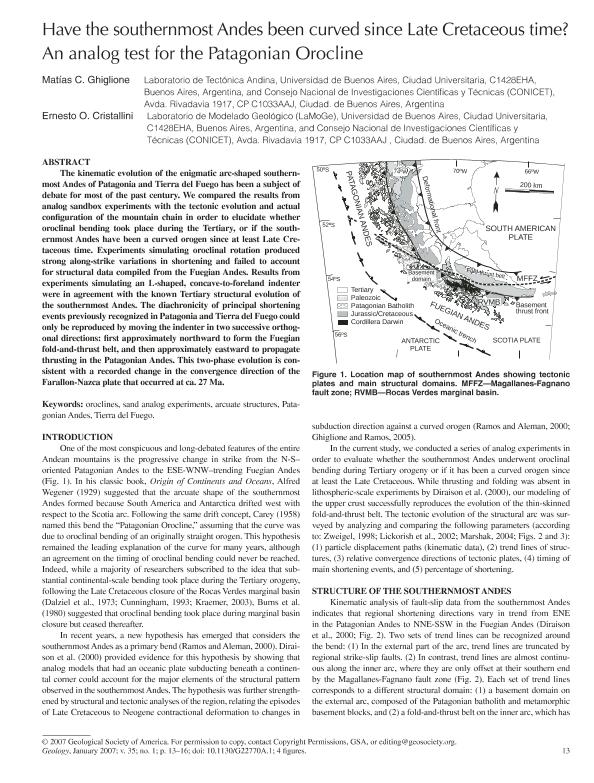Mostrar el registro sencillo del ítem
dc.contributor.author
Ghiglione, Matias

dc.contributor.author
Cristallini, Ernesto Osvaldo

dc.date.available
2019-12-23T16:57:49Z
dc.date.issued
2007-01
dc.identifier.citation
Ghiglione, Matias; Cristallini, Ernesto Osvaldo; Have the southernmost Andes been curved since Late Cretaceous time? An analog test for the Patagonian Orocline; Geological Society of America; Geology; 35; 1; 1-2007; 13-16
dc.identifier.issn
0091-7613
dc.identifier.uri
http://hdl.handle.net/11336/92760
dc.description.abstract
The kinematic evolution of the enigmatic arc-shaped southernmost Andes of Patagonia and Tierra del Fuego has been a subject of debate for most of the past century. We compared the results from analog sandbox experiments with the tectonic evolution and actual configuration of the mountain chain in order to elucidate whether oroclinal bending took place during the Tertiary, or if the southernmost Andes have been a curved orogen since at least Late Cretaceous time. Experiments simulating oroclinal rotation produced strong along-strike variations in shortening and failed to account for structural data compiled from the Fuegian Andes. Results from experiments simulating an L-shaped, concave-to-foreland indenter were in agreement with the known Tertiary structural evolution of the southernmost Andes. The diachronicity of principal shortening events previously recognized in Patagonia and Tierra del Fuego could only be reproduced by moving the indenter in two successive orthogonal directions: first approximately northward to form the Fuegian fold-and-thrust belt, and then approximately eastward to propagate thrusting in the Patagonian Andes. This two-phase evolution is consistent with a recorded change in the convergence direction of the Farallon-Nazca plate that occurred at ca. 27 Ma.
dc.format
application/pdf
dc.language.iso
eng
dc.publisher
Geological Society of America

dc.rights
info:eu-repo/semantics/openAccess
dc.rights.uri
https://creativecommons.org/licenses/by-nc-sa/2.5/ar/
dc.subject
ARCURATE STRUCTURES
dc.subject
OROCLINES
dc.subject
PATAGONIAN ANDES
dc.subject
SAND ANALOG EXPERIMENTS
dc.subject
TIERRA DEL FUEGO
dc.subject.classification
Geología

dc.subject.classification
Ciencias de la Tierra y relacionadas con el Medio Ambiente

dc.subject.classification
CIENCIAS NATURALES Y EXACTAS

dc.title
Have the southernmost Andes been curved since Late Cretaceous time? An analog test for the Patagonian Orocline
dc.type
info:eu-repo/semantics/article
dc.type
info:ar-repo/semantics/artículo
dc.type
info:eu-repo/semantics/publishedVersion
dc.date.updated
2019-11-08T15:12:43Z
dc.journal.volume
35
dc.journal.number
1
dc.journal.pagination
13-16
dc.journal.pais
Estados Unidos

dc.journal.ciudad
Boulder
dc.description.fil
Fil: Ghiglione, Matias. Consejo Nacional de Investigaciones Científicas y Técnicas. Oficina de Coordinación Administrativa Ciudad Universitaria. Instituto de Estudios Andinos "Don Pablo Groeber". Universidad de Buenos Aires. Facultad de Ciencias Exactas y Naturales. Instituto de Estudios Andinos "Don Pablo Groeber"; Argentina
dc.description.fil
Fil: Cristallini, Ernesto Osvaldo. Consejo Nacional de Investigaciones Científicas y Técnicas. Oficina de Coordinación Administrativa Ciudad Universitaria. Instituto de Estudios Andinos "Don Pablo Groeber". Universidad de Buenos Aires. Facultad de Ciencias Exactas y Naturales. Instituto de Estudios Andinos "Don Pablo Groeber"; Argentina
dc.journal.title
Geology

dc.relation.alternativeid
info:eu-repo/semantics/altIdentifier/doi/http://dx.doi.org/10.1130/G22770A.1
dc.relation.alternativeid
info:eu-repo/semantics/altIdentifier/url/https://pubs.geoscienceworld.org/gsa/geology/article-abstract/35/1/13/129658/Have-the-southernmost-Andes-been-curved-since-Late
Archivos asociados
